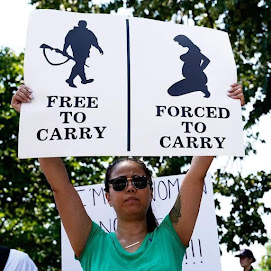by Mark Morford
This is the chart.
This is the chart that blows away all other charts, that makes babies melt and flowers scream, that equally intoxicates and befuddles all viewpoints along the political spectrum; it’s the meta-, mega-, uber-chart that you rarely hear anyone in the corridors of power fight much about, not in the normal sense anyway, largely due to its stupendous insanity, imposing wastefulness, open-palmed insult to all you ever cared about.
Really, how can you
not be sort of amazed, in a gross-all-over kind of way, when you see how the US military budget is so vast, so grotesquely outsized that, at upwards of $600 billion, it not only dwarfs all other expenditures in our economy, it’s actually larger than the military budgets of the next 10 major world powers on the planet,
combined?
Whenever I hear that factoid, I just can’t make it scale. It just sits there, like a lump, a massive tumor on the face of the nation that no one dares mention, even though it’s the size of Mars. Even today, after many post-Cold War budget cutbacks, we still spend 10 times more than Russia, five times more than China, and so on. No one else even comes close. Is this not viciously surreal? Insane?
It’s not exactly something to be proud of.
And we can now add to the list of Obama depressants the fact that the president just proposed
a massive increase to the US military budget, far larger than Congress allows (and they allow a lot), most of it earmarked for ongoing wind-down in Afghanistan, attacking the extremist freak-show that is ISIL, and to “modernize” the creaky US military so as to better keep up with technological advances in China and elsewhere, so we’re better able to combat – well, who knows what. Chinese robots? Magic drones? Awful comedies about North Korea? Impossible to know.
Also impossible to know: Why we can’t simply redirect billions away from failed, bloated military programs we don’t actually need, of which there are dozens, to the ones the Pentagon is arguing we really, really do.
Maybe you’re brave enough to offer forth a very reasonable, albeit largely unanswerable question:
Why is our military budget so massive? How did this happen? Do we really need that much firepower? Does anyone? Even the most hawkish among us might allow that there’s no need to have 11 nuclear-powered aircraft carriers – each costing upwards of $7 million to operate,
per day – on active duty when China just recently launched
its first carrier ever, and it’s
kind of a joke.
Or maybe you’re one of those angry dad/Donald Rumsfeld types who likes to argue how great it is that, if we had to, we could fight a dozen wars simultaneously, across the planet,
and handle the zombie apocalypse and the Second Coming, the terrorist jihad and the epic water wars, all at once.
Are you reassured? Don’t be. It’s a preposterous lie. Despite our size (or rather, because of it) we are far too fat, too expensive and too wasteful to nimbly handle multiple wars – as if that situation could ever exist. Hell, Bush’s Iraq disaster cost a trillion dollars, lasted eight years and nearly wiped us out, and we didn’t even have an enemy.
What the US does very well, however, is
intervene. Our agenda has become to embroil ourselves in dozens of lesser, but no less vicious, battles, invasions, attacks, overthrows across the planet,
in the name of democracy and American values. Our country is indeed at perpetual war with someone, somewhere – not in the name of protecting ourselves (we have no viable enemy in the larger sense), but in the name of spreading our agenda. Libya? Panama? Bosnia? ISIL? Lebanon? Gulf War? You name it, we’ve been there – and maybe still are.
Does this help explain the $600 billion? Sort of. But not exactly.
What explains it most of all, I think, is high fructose corn syrup.

Obama’s budget. Some good things. Some awful things. Like $53 billion for more military operations.
You remember the opening chapter of
Omnivore’s Dilemma? Michael Pollan described how, thanks to awful farm bills, vicious tactics of the farm lobby and various flaccid USDA rules, many American farmers are currently paid to grow nothing but massive quantities of commodity (read: inedible) corn, vast mountains of it, far more than we could ever possibly need.
And there it sits. We have to do
something with it, right? So to make room for more, we invent all sorts of unnatural uses for that barely usable corn. We force feed it to cows. We jam it into products. We invent all sorts of additives, gums, ethanols, preservatives. But mostly, we convert it into a disgusting, diabetes-igniting sugar additive, HFSC, and slap that junk into
everything, from vitamins to bread, ketchup to corn chips, thousands of products and millions of pounds of sugary goop that has no business being there. Because all that corn sugar has to go
somewhere. Might as well help make America sick and obese, right?
So it is with the US military. Endless paranoia, overspending, interventionism and military-industrial complex lobbying have led us to have so much excess military, we’re sort of compelled to put it to use,
somehow.
So while our schools decay, our highways crumble and politicians whine about paying for the health care of the most needy among us, we spend hundreds of billions fighting multiple “wars” that aren’t really wars. We invade. We overthrow. We airstrike. We position a dozen nuclear aircraft carriers all over the ocean, the hulking bullies of our police-the-world agenda. And we ask for tens of billions more to maintain and “upgrade” the barely controlled chaos that is our military. Because what else are you gonna do, work toward peace?
Meanwhile, all the surplus, leftover equipment from wars past, all those millions of tons of tanks, machine guns, armored vehicles, grenade launchers and other hardcore gear get dumped into the clumsy, untrained hands of local police forces who almost can’t help but use it for its intended purpose: oppression, containment, violence, death.
Against who? Against the only enemy left: ourselves.






































